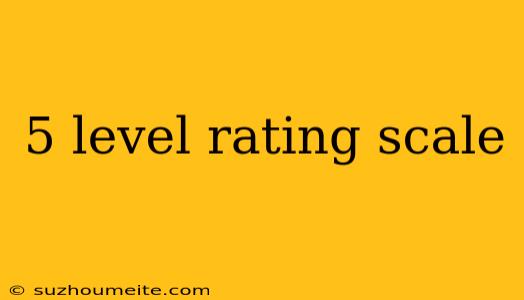5 Level Rating Scale: Understanding the Basics
In various aspects of life, rating scales are used to measure opinions, attitudes, and feelings towards products, services, or experiences. One of the most common rating scales used is the 5-level rating scale, also known as the 5-point Likert scale. In this article, we will delve into the world of 5-level rating scales, exploring its benefits, limitations, and applications.
What is a 5-Level Rating Scale?
A 5-level rating scale is a type of rating system where respondents are asked to rate their agreement or opinion on a particular statement or question using a scale of 1 to 5. The scale typically ranges from Strongly Disagree (1) to Strongly Agree (5), with three intermediate options: Somewhat Disagree (2), Neutral (3), and Somewhat Agree (4).
Benefits of 5-Level Rating Scale
The 5-level rating scale offers several benefits, including:
Easy to Understand
The scale is simple and easy to understand, making it accessible to a wide range of respondents.
Sufficient Granularity
The 5-level scale provides a good balance between simplicity and granularity, allowing respondents to express their opinions with some degree of nuance.
Quantifiable Data
The scale produces numerical data, making it easier to analyze and compare results.
Limitations of 5-Level Rating Scale
While the 5-level rating scale is widely used, it is not without its limitations. Some of the drawbacks include:
Limited Scope
The scale may not be able to capture complex or nuanced opinions, as respondents are forced to choose from a limited set of options.
Central Tendency Bias
Respondents may tend to choose the middle option (Neutral) to avoid taking a strong stance, leading to biased results.
Lack of Precision
The scale may not provide precise measurements, as respondents may interpret the scale points differently.
Applications of 5-Level Rating Scale
The 5-level rating scale has a wide range of applications, including:
Customer Satisfaction Surveys
The scale is commonly used in customer satisfaction surveys to measure opinions on product or service quality.
Market Research
It is used in market research to gauge attitudes towards brands, products, or services.
Academic Research
The scale is used in academic research to measure opinions on various topics, such as political attitudes or social issues.
Conclusion
In conclusion, the 5-level rating scale is a widely used and effective tool for measuring opinions and attitudes. While it has its limitations, the benefits of ease of understanding, sufficient granularity, and quantifiable data make it a popular choice in various applications. By understanding the basics of the 5-level rating scale, researchers and professionals can effectively design and implement surveys that yield valuable insights.
